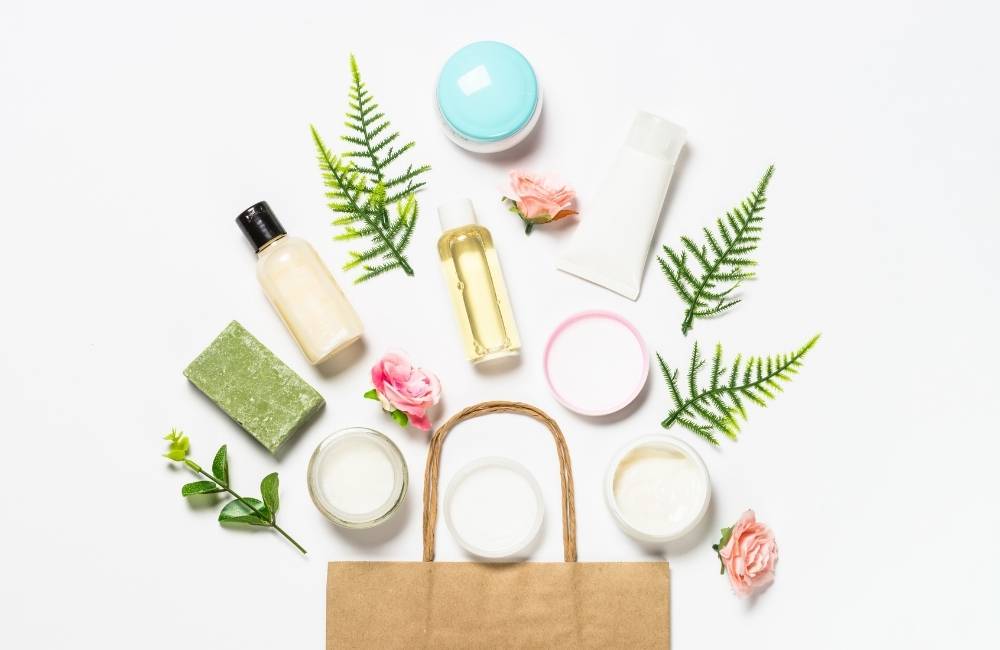Whether it’s for the sake of our health, the planet, or the animals, more and more of us are turning towards plant-based eating, or at least looking to reduce the amount of meat and dairy we consume.
The next logical step is to take a closer look at what goes into our beauty products – and you might be surprised at how many are hiding in your everyday products from soap to shampoo.

Let’s look at the most-common animal products in makeup and skincare that we often overlook.
Contents
#1 Tallow / Fatty Acids
Tallow is rendered down cow, sheep or pig fat. While you’re unlikely to see the word ‘tallow’ on a list of ingredients, you may well see some of the extracted and refined fatty acids that tallow is comprised of, such as Stearic Acid, Oleic Acid, Lauric Acid, Palmitic Acid and Myristic Acid. Most of these acids are valued for their deeply moisturizing properties.
While they may be individually derived from non-animal sources, tallow-derived fatty acids are commonly found in lotions, creams, foundations, lipsticks, soaps, cleansers, shampoo – you name it! Bar soap often contains tallow too – usually on the label as Sodium Tallowate.
#2 Glycerine / Glycerin / Glycerol
As mentioned, soap is commonly made from animal fat, and glycerin is a by-product of the manufacturing process.
Glycerin can be derived from plant sourced such as grapeseed oil, soya, coconut oil or palm oil. The animal-free form of it is quite commonly used in in the food industry, whereas in cosmetics it may well be animal- based – so if you’re trying to avoid animal products, look out for ‘vegetable glycerin’ on the label or contact the company to be sure.
This animal-based ingredient is used in the production of everything from make up to hair care even toothpaste.
#3 Lanolin
Lanolin is a waxy substance produced by sheep to help keep their woolly coats dry. Its greasy quality means it’s commonly used in products that demand a glossy finish or a waterproof barrier, such as lipsticks, balms and glosses, and in emollient products to soften and moisturize very dry and flaky skin.
You may come across ‘cruelty-free’ lanolin, but it usually still comes from wool. Natural butters and waxes make good animal-free alternatives.
#4 Animal Hair
As well as products derived from animal hair, the hair itself is often used. Shaving brushes can be made from boar bristles, while fibers on make-up brushes can be made from the coats of various animals including sable, fox, squirrel, goat and mink.
Mink hairs are also commonly used as eyelash extensions, usually fibers taken from the tails of the Siberian or Chinese breeds of mink. Mink lashes are very soft and natural looking, but as well as being not-suitable for vegans. They are expensive and require curling.
Synthetic lashes, whether they are referred to as ‘faux mink’ or ‘silk lashes’ are made from Polybutylene Terephthalate (PBT). The difference in labelling just refers to their shape and finish, which may vary from brand to brand.
#5 Guanine
It’s not just animal hair that’s highly prized – fish scales have their use in the beauty industry too. They are crushed up to create a product called Guanine. The ingredient is found in products to create a shimmery or sparkly finish, for example in iridescent nail polish, highlighters, bronzers and blushers.
#6 Squalene / Squalane
From fish scales to… shark liver oil. Our body naturally produces squalene – we release it through our sebaceous glands, which is why it has incredibly moisturizing and anti-aging properties for use in skincare. It’s also used in bath oils, make up, hair care and sunscreen.
Shark livers are filled with Squalene – this is converted to the more stable, hydrogenated product called Squalane, which is what you’ll see on product labels. Vegan forms of Squalane are readily available – it can be made from olives, sugar cane and rice bran.
#7 Cochineal / Carmine
Those gorgeous red and pink tones in your lipstick, blush and nail polish? There’s a good chance they’re derived from the cochineal beetle. The female of the species lives off red cactus berries, meaning when they are crushed they create a very intense red coloring that is also known as Carmine.
#8 Collagen
While applying collagen products directly to the skin has been refuted as being effective as the molecules are too large to be absorbed, taking collagen supplements to improve skin elasticity and plumpness has become very popular, with many celebrity advocates.
There is currently virtually no plant-based form of collagen available – instead vegan alternatives usually contain ingredients designed to boost the body’s own collagen production. This means that any form of collagen comes from animal sources, be it pigs, cows or fish, aka ‘marine collagen’.
#9 Beeswax
Beeswax derives from melted and clarified honeycomb from beehives. It’s inexpensive which means is used broadly across the cosmetics industry, in products from lipsticks and lip balms to creams and eyeshadows. A number of plant-based waxes are available as an alternative, for example for soy, sunflower, carnauba, coconut and candelilla. Other products from bees that beauty industry uses include royal jelly and propolis.
The bottom line
That’s our rundown of some of the most common animal by-products in cosmetics – but really, we could go on and on! If this is an issue that you are concerned about, look for the vegan label on products, and remember that expressions such as ‘natural ingredients’ and ‘cruelty-free’ do not mean animal-free.